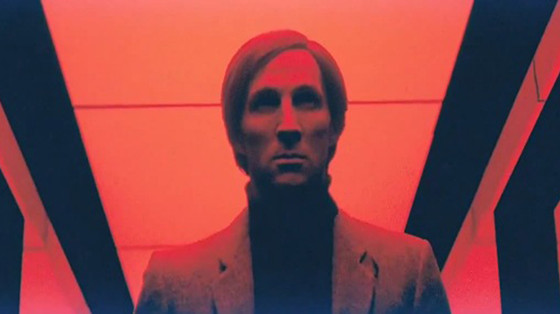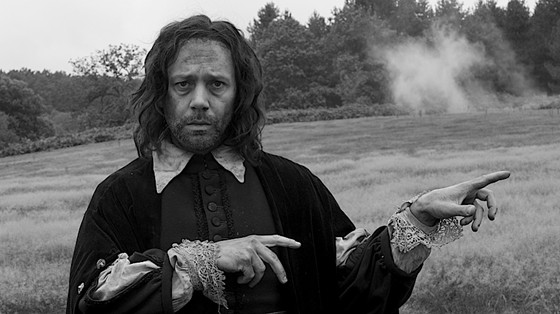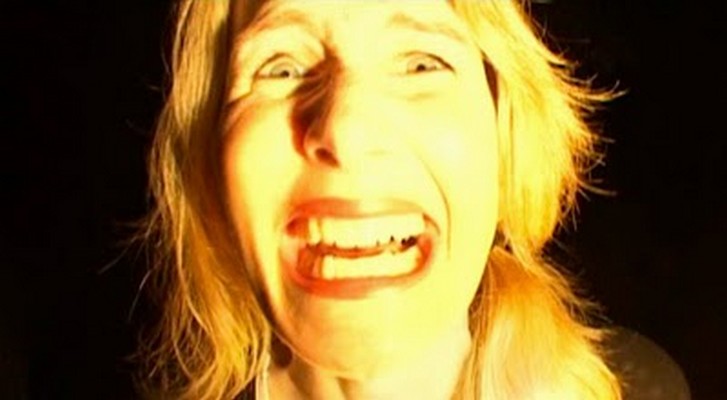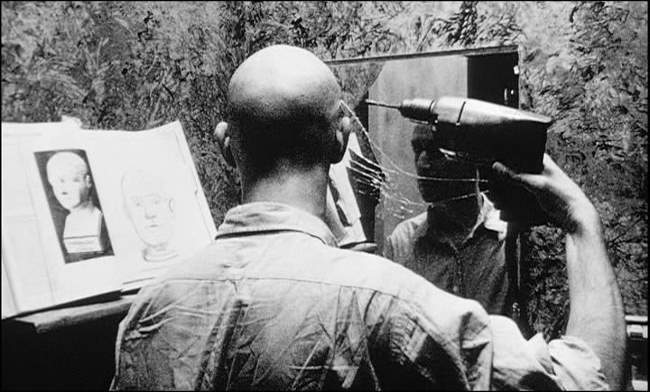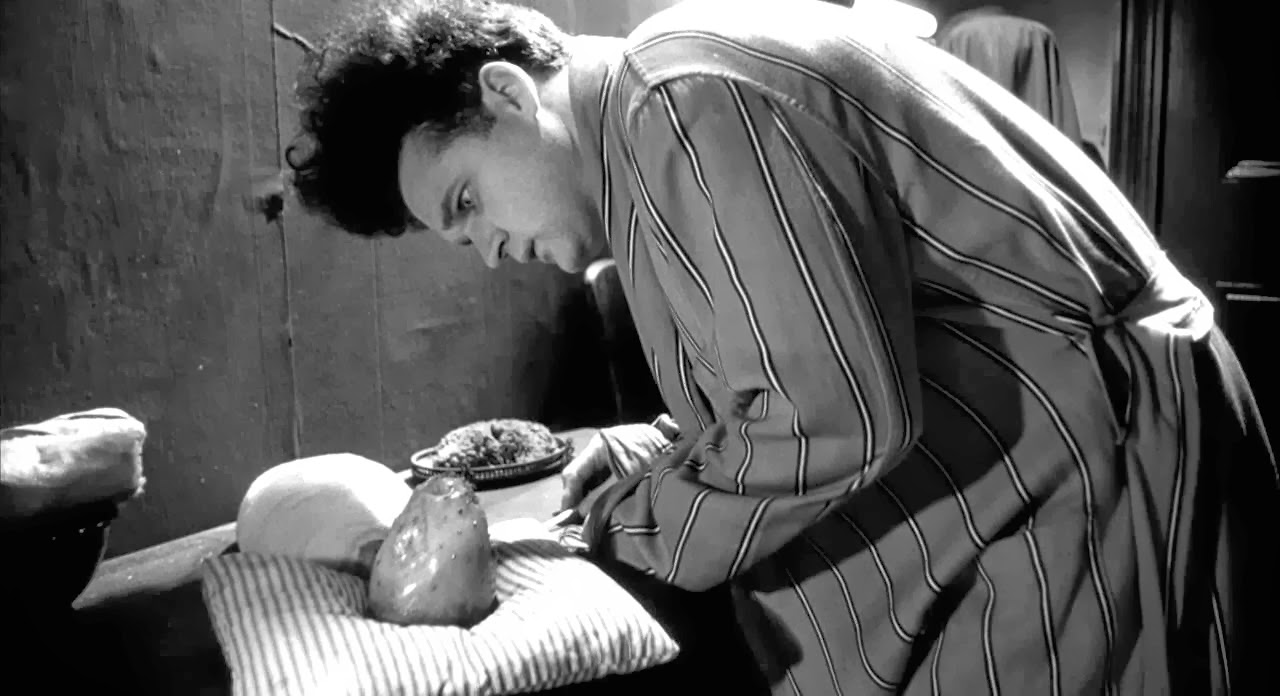5. Beyond The Black Rainbow (2010)
Part of a growing number of “retro period” genre films that have come about in the last decade, Beyond The Black Rainbow is original for its semi-futuristic take on a dystopian world circa 1983. A highly stylized mood piece, BTBR is part of the “slow-burn” school of horror that favors the mounting atmosphere of claustrophobic dread over fast-paced action and quick-cutting blood spatter.
As a patient in the decaying Arboria Institute located in a rural countryside somewhere in Canada, a young woman named Elena is virtually catatonic and visibly disturbed. As she is probed for emotional response by a creepy controlling older man named Barry in an early scene the eerie tone of film sets in. From there the tension mounts slowly as clues start to reveal what kind of place the Arboria Institute used to be compared to the dark and cold shell of a futuristic compound it is now. Elena starts to reveal hidden powers beyond Barry’s control and Barry’s past is revealed in a psychedelic flashback / dream sequence that needs to be seen to be believed.
The strange relationship between Barry and Elena makes up the bulk of the film with much of it being shot in gorgeous grainy close-ups and beautifully composed angular compositions emphasizing the retro set design. First-time director Panos Cosmatos takes extreme care in designing and pacing each frame of the film which may put off certain viewers but leads to a powerful climax full of resonance. This film is worth seeing for the visual design and psychedelic flashback sequence alone.
4. A Field In England (2013)
UK Director Ben Wheatley has proven to be rather prolific in the last few years with several of his films earning almost instant cult-status and a growing reputation as a genre-bending filmmaker. While his 2011 film Kill List was his most popular among critics and indie audiences, his follow-up film A Field in England is a more ambitious and risky project.
As far as period films go, no one would confuse A Field In England with a Jane Austen adaptation. Filmed in Black and White and set in the 17th century during the British Civil War, AFIE feels like a throwback to the days of early 1970s European arthouse cinema. Its like a low budget Hammer production on LSD.
Beginning with the sounds of a disorienting battle sequence, an alchemist’s assistant named Whitehead joins two army deserters as they escape the violence only to emerge from a densely wooded area to an open field. From there the three bedraggled men try to journey across the field to find an ale-house but instead set-up camp and try to feed themselves by cooking up a soup made of mushrooms found nearby.
Soon their camp is infiltrated by a criminal named O’Neill who exerts domination over them to find a buried treasure. The events that follow become more and more surreal as the soup they ingested turned out to have had hallucinogenic mushrooms in it and the criminal O’Neill seems to possess supernatural powers and a murderous bent.
The key to viewing a film like A Field In England is the same as that of any other film on this list in that the viewer simply must cultivate an open mind to allow for its eccentric mood to take hold. Once the mood does set in there is plenty of depth in character and concept to enjoy. If that doesn’t quite satisfy there is always the climactic psychedelic sequence with strobe-effect editing and surreal split-screen techniques to galvanize the viewer into submission.
3. Inland Empire (2006)
David Lynch may be one of the most well known avant garde directors to ever break into the mainstream but with his last feature film, Inland Empire, from 2006, he effectively cut all ties to the concept of mainstream filmmaking and the consensus of what a general audience wants out of a moviegoing experience.
Made partially through Lynch’s own money as well as private donors over the course of two and a half years, Inland Empire is a sprawling elegiac nightmare of a film that chronicles the slowly disintegrating world of Nikki Grace. As played by Laura Dern, Nikki is a celebrated Hollywood actress poised for the biggest role of her career.
Summed up with the logline “A Woman in Trouble” the multi-dimensional and temporally shifting narrative of Inland Empire mines territory about four-times as alienating as Lynch’s previous film Mulholland Drive but with so much more of a frightening commitment to exploring the depths of mental fugue states and Hollywood underworld hell-scapes.
While Blue Velvet, Lost Highway and Mulholland Drive play like wonderfully bizarre twists on the psychological thriller template, Inland Empire goes full on into horror movie excess and paranoia. It’s an epic head trip that may turn many casual viewers off, but for the truly adventurous its rewards are manifold.
2. Pi (1998)
The breakthrough debut feature for Darren Aronofsky, famed director of such dark and disturbing films as Black Swan and Requiem for a Dream, Pi was a hit on the arthouse circuit back in 1997 when it premiered. Having won numerous awards and garnering much festival notoriety, Pi became Aronofsky’s calling card and paved the way for his transition in higher budgeted studio backed projects.
Filmed on grainy black and white 16mm film, Pi immediately leads us into the paranoid world of Max Fisher from its opening frame. A brilliant mathematician living alone in a seedy studio apartment in New York, Max is working on an important breakthrough in the form of an equation that could help him unlock the key to finding a pattern in the numerical framework of the stock market. As Max becomes more obsessed with his developing calculations, he’s also plagued by violent migraine headaches that border on psychotic episodes. Soon he finds himself a literal target from multiple shady underground groups from corporate extortionists to Kaballa-obsessed Rabbis — all wanting desperately to get at the valuable equation inside Max’s head.
As Max’s odyssey spirals into chaos, his mind distorts reality and his hallucinations start to drive him mad. Several hallucinations and dream sequences are interspersed throughout the narrative and give Aronofsky the opportunity to expand on the distorted visual and auditory world that Max inhabits. Faced-paced editing, innovative POV camera placement and a pulsing 90’s flavored techno score all combine to make this a tour de force of stylish filmmaking.
1. Eraserhead (1977)
Back in 1973 a talented young artist / filmmaker was attending art school and had the crazy idea of making an experimental film that followed along with some of the short films he’d already been making. He liked making dark and strange imagery and some of his short films even featured bizarre stop-motion animation mixed in with live action footage. So this young artist got a bunch of friends together, similar young artists types, and through a grant was awarded the funds to start his production… Thus was born Eraserhead.
Eraserhead is the Mother of all Surreal Independent Horror movies. Eraserhead is one of a kind. Nothing else compares to it. Given the logline: “A Dream Of Dark and Troubling Things” by its creator David Lynch, Eraserhead became a midnight movie phenomenon back when it premiered in New York in 1977. It took Lynch a full 5 years to complete this beautiful nightmare of a movie.
Much has been written and analyzed and purported concerning the meaning behind so much of the mystery in the film but to Lynch’s credit he has remained very cagey about what it all amounts to. This only adds to the power of a film that on the surface can be described as a dark story about a young man named Henry struggling to keep his marriage afloat after his young bride gives birth to a deformed mutant baby.
The world Henry inhabits seems like that of a nightmarish cross between a German Expressionist film and an overly industrialized Film Noir night-scape. As Henry struggles to deal with being a father to his sick and deformed child, along with the constraints of being married to his young, distraught wife he finds himself slipping into dark surreal dream states.
This is all part of the brilliance of Lynch’s vision because even though large portions of the film seem to exist in a surreal half-reality and half-nightmare world, it all feels like it fits together and is designed that way intentionally. Lynch’s vision is so singular here that no one has ever tried to copy it, even though it became a successful money-making hit on the midnight circuit in the late 70’s.
Most mediocre filmmakers wouldn’t have a clue how… Only in films by equally visionary directors like Tim Burton’s Beetlejuice, Darren Aronofsky’s Pi and Alex Proyas’ Dark City can there be found any similar stylistic concepts but defining just how they all intersect seems difficult given how singular they all are. It’s a fool’s game to try to compare Eraserhead to any other film. It is truly one of a kind, a masterful work of art, one that rightfully earns its place among the best films ever made and proof that great art — great surreal art in the horror genre — can be made by independent filmmakers.
End Note: All films on this list can be found on DVD and thankfully Eraserhead has finally gotten released on BluRay via the prestigious Criterion Collection.
Author Bio: Michael Okum is a filmmaker and visual artist living in Glendale California. He just completed his first independent feature film as writer-director, the psychedelic horror-thriller “Expressway To Your Skull”. Check out the trailer Here on Vimeo or go to www.expresswaytoyourskull.com for more info.
